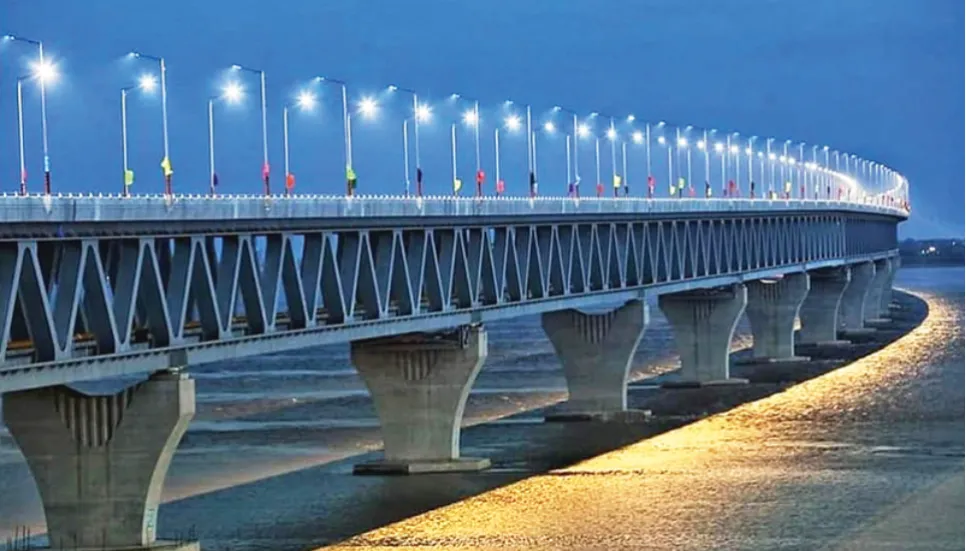
The total combined output in the entire Bangladesh economic corridor region is expected to increase from $32 billion in 2020 to $286 billion by 2050 in the business-induced scenario (BIS) due to the intervention.
Along the timeline, the total corridor region BIS output is expected to split off from the business as usual scenario's output and gradually increase to become 1.4 times of the total corridor region business as usual output by 2030, and 2.6 times by 2050, said the Bangladesh Economic Corridor Development Highlights launched by the Asian Development Bank (ADB) at the Bangabandhu International Conference Center (BICC) in the capital today.
Planning Minister MA Mannan spoke at the function as the chief guest while Executive Chairman of the Bangladesh Economic Zones Authority (BEZA) spoke as the special guest.
ADB country director for Bangladesh resident mission Edimon Ginting made the welcome remarks while additional secretary of Economic Relations Division (ERD) Md Mostafizur Rahman gave the opening remarks.
ADB senior country specialist Soon Chan Hong made a PowerPoint presentation while ADB director on public sector management and governance Sabyasachi Mitra, Director (Finance) of PRAN-RFL Group Uzma Chowdhury and chairman of Policy Exchange Bangladesh Dr Masrur Reaz spoke at the discussion session.
Bangladesh Investment Development Authority (BIDA) executive member Avijit Chowdhury gave the vote of thanks.
Speaking on the occasion as the chief guest, Planning Minister MA Mannan said that there are corridors in every country and there is a need to create adequate bypasses in Dhaka to have maximum outputs and economic benefits towards developing the economic corridors.
He mentioned that in the haor region covering Sunamganj and Netrakona districts, the government has started building flyovers to boost connectivity.
To ensure optimum development, the Planning Minister said there is a need for social, economic and political stability in the country so that the cross-section of people including workers, farmers, day labourers and businessmen could accomplish their tasks easily.
"It's our responsibility to create that scope...we don't need political vengeance rather we need to have inclusiveness and moderate mindset in politics as like in trade and commerce," he added.
The Planning Minister noted that the nation needs to give Prime Minister Sheikh Hasina another chance to serve the country as well as to continue the development spree.
BEZA executive chairman Shaikh Yusuf Harun said that the economic corridor would play a pivotal role in catalyzing the economic zones being developed across the country by BEZA.
"The economic corridor will undoubtedly stimulate economic enhancement and regional integration alongside creating more employment opportunities....it will foster cultural exchange, our agriculture will be better connected to the markets, farmers will get better prices while tourism and other sectors will be facilitated," he added.
In his address, ADB country director Edimon Ginting said that the Northeast and the Southwest regions of Bangladesh are lagging in terms of development as this corridor will make them the new centre of growth.
He said that the economic corridor will boost regional cooperation.
Noting that India is a very dynamic neighbour to Bangladesh, Ginting said the regional trade between India and Bangladesh is still small compared to the ASEAN countries. But, the development of this corridor could enhance the trade potential, he added.
The ADB country director mentioned that the lending agency has already provided support to several development projects along the Bangladesh Economic Corridor which includes the South Asia Subregional Economic Cooperation Dhaka-Sylhet Corridor Road Investment Project and urban development projects in Khulna district.
Dr Masrur Reaz said that integrated economic planning and infrastructures beyond the Padma Bridge are very critical to ensure that the southwest region gets the right development impact.
He said regional development needs upgradation in the trade gateways, and improved facilities in the borders, in the land ports and sea ports.
According to the Bangladesh Economic Corridor Development Highlights, it has been estimated that the whole corridor is expected to generate additional employment of 2.3 million jobs by 2050 and then gradually increase to 40.7 million jobs by 2050.
As such, the total employment generated in the corridor region is expected to be 15.7 million in 2025 and 71.8 million in 2050. This is about 2.3 times the Employment that is expected to be generated in the corridor region by 2050 compared to the business-as-usual scenario.
Based on the outcome of the analysis, 12 manufacturing industries were shortlisted for the whole Bangladesh Economic Region. These are food processing, leather and footwear, textiles and ready-made garments (RMGs), Jute, nonmetallic mineral manufacturers, shipbuilding, furniture, transport equipment, pharmaceuticals, plastic products, rubber and rubber products, electrical and electronics machinery, and heavy machinery.
Currently, northeast and southwest Bangladesh are key lagging regions in the country. Hence, for uniform, holistic and sustainable development across the length and breadth of Bangladesh, the Bangladesh Economic Corridor has been conceptualized running from the southwest region (Khulna Division) to the northeast region (Sylhet and Mymensingh divisions) via Dhaka.
The entire economic corridor encompasses 14 districts, covering 34 per cent of the total population. Most northeastern districts of BEC are included in one of the six hotspots (grouping of districts facing similar natural hazard risk)-haor and flash flood areas of Bangladesh Delta Plan 2100. Southwestern districts of the economic corridor are predominantly represented in the coastal zone hotspot of Bangladesh Delta Plan 2100.